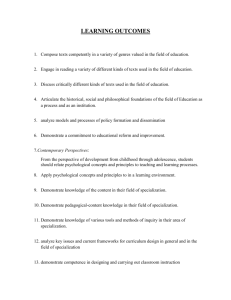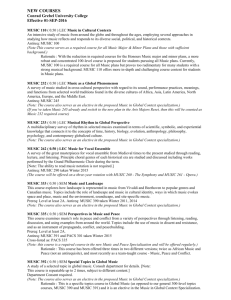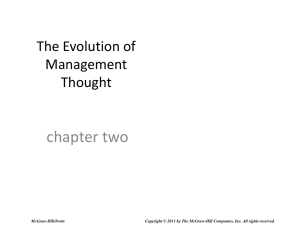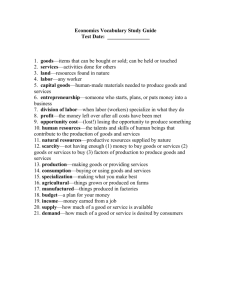Money: Its Functions and Characteristics
advertisement
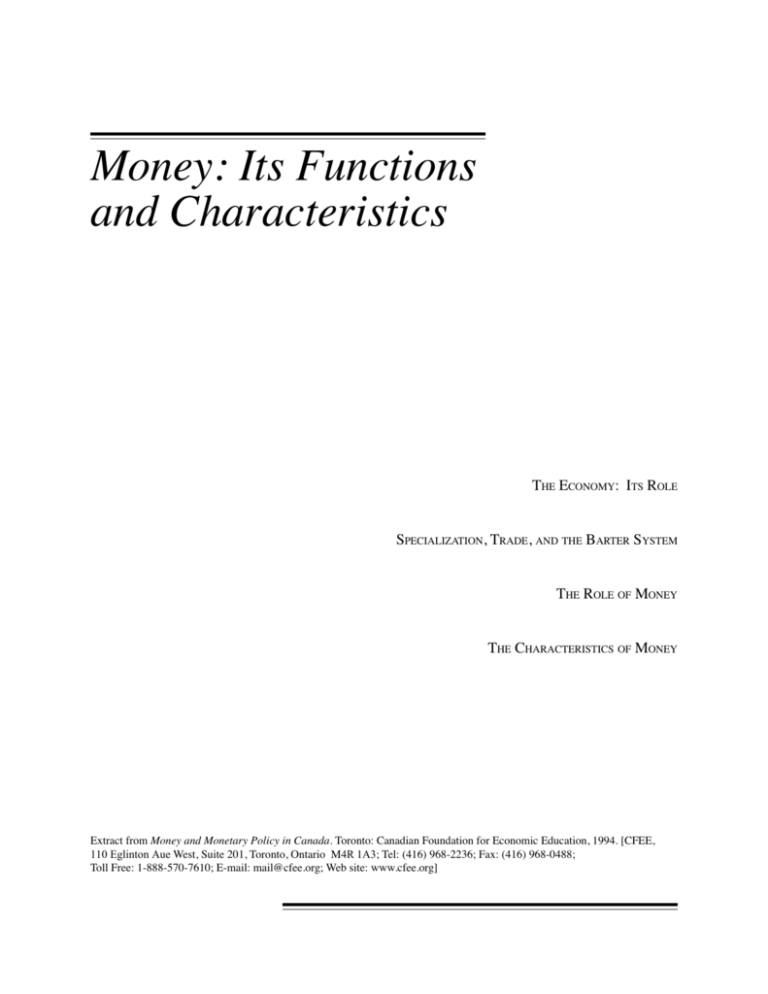
Money: Its Functions and Characteristics THE ECONOMY: ITS ROLE SPECIALIZATION, TRADE, AND THE BARTER SYSTEM THE ROLE OF MONEY THE CHARACTERISTICS OF MONEY Extract from Money and Monetary Policy in Canada. Toronto: Canadian Foundation for Economic Education, 1994. [CFEE, 110 Eglinton Aue West, Suite 201, Toronto, Ontario M4R 1A3; Tel: (416) 968-2236; Fax: (416) 968-0488; Toll Free: 1-888-570-7610; E-mail: mail@cfee.org; Web site: www.cfee.org] Many people think that our economy and the study of economics are concerned primarily with money—how to get it, how to spend it, and how to get more of it. But money is often assigned more importance than it is due, and economics does not focus exclusively on the study of money. To understand the role of money, we first need to understand the role of an economy. Let’s begin our trip there. THE ECONOMY: ITS ROLE People have many needs and wants—cars, tables, taxi rides, medical services, computers, doors, pens, tires, theatres, and on and on and on. People need and want goods and services for two primary reasons: (i) to survive (which involves such necessities as food, clothing, and shelter) and (ii) to enhance the enjoyment and comfort of life (which involves things that make life better than what is required for mere survival). The economy’s job is to try to respond to these desires for goods and services—to produce the goods and services and, we hope, continually enhance people’s ability to obtain them and live their desired lifestyle. Although the economy produces goods and services in response to people’s needs and wants, people learn very early in life that they can’t have everything they want. The economy does not satisfy everyone’s needs and wants. Why? The main reason is that society’s resources are limited. Our resources—our natural resources, our available labour and capital (plants, factories, equipment), along with existing technology— are in limited supply. These resources are brought together by entrepreneurs to produce goods and services for our economy. Entrepreneurs examine the needs and wants of people in a society and then respond by using resources to initiate new ventures. If our resources weren’t limited, every society could produce everything that everyone wanted. We could all have ten computers, five houses, twelve cars, three boats, and so on. But there are only so many trees, so many minerals, so many people. The limitations imposed by our resources pose an economic challenge to our society. We have to decide how to use our available resources in the best way possible. We can’t have everything we want. Choices and trade-offs have to be made. But how do we determine how well an economy is meeting our needs and wants? There are two ways of looking at how well our economy is responding to people’s needs and wants. One way is to look at our standard of living. The other is to consider our quality of life. How do we arrive at a standard of living for our economy? Remember that the job of an economy is to produce goods and services in response to people’s needs and wants. To arrive at a standard of living in an economy, we can add up the total value of all the goods and services produced in a society and divide that total by the number of people in the society. The following shows the dollar value of output per person produced in the Canadian economy in 1991 and 1992. 1991 GDP per capita: $24,039.00 1992 GDP per capita: $24,214.00 2 Money: Its Functions and Characteristics This shows us that the dollar value of output produced in Canada in 1992 was higher than that in 1991. Therefore, on average, Canadians were better off, right? Our standard of living was higher, right? Actually, from this information, we can’t tell. Why not? When we add up the value of things in an economy, we tend to add them up according to their monetary value or price. In an economy, two identical hockey sticks produced and sold in two different years may not be the same in terms of their “price.” The same stick may sell for $19.95 in one year and $27.95 in the next. The funds required to purchase the same stick differ because of the higher price. To know whether or not our standard of living has increased, we would have to eliminate the influence of higher prices. To measure changes in our standard of living, we have to consider the actual output of goods and services we produce, not just the dollar value of the goods and services. After all, if we produce 100,000 hockey sticks one year and 100,000 hockey sticks the next year, there is no change in the number of hockey sticks available for sale and use. We want to make sure that a higher price for those sticks doesn’t trick us into thinking more was produced when it wasn’t. It is important to understand that one way we assess how well an economy is meeting society’s needs and wants is to divide the value of goods and services that a nation produces by its population, making sure to factor out the effects of changing prices. However, it is important to remember that when we calculate the standard of living in a nation, we still don’t know anything about how wealth and income are distributed in a particular country. If we are told that the value of output is $24,214.00 per Canadian, we know that is not what every Canadian gets. Some get less. Some get more. Standard of living is an average. Standard of living measurements are used as one means to assess how “well off” a society is. At the same time, though, I’m sure you’ve heard the expression: “Money can’t buy happiness.” There are other considerations in life besides material well-being. These include environmental quality, peace, freedom, happiness, and so on. To assess a society’s well-being in this broader sense, we need to look at quality of life. Measuring the quality of life in a society is much more difficult than measuring the standard of living. How do we measure the value of clean air, clean water, park land, animals, peace of mind, happiness, and freedom? Although we recognize that quality of life is extremely important, the focus here is more on the economic factors that affect the standard of living— the economy’s ability to produce goods and services and how the economy can be encouraged and assisted to improve a society’s standard of living over time. The primary challenge for any economy, then, is to decide how to use available resources to produce goods and services in response to needs and wants. Money can help. But how? So far, we haven’t identified a role for money. Let’s move along. Money: Its Functions and Characteristics 3 SPECIALIZATION, TRADE, AND THE BARTER SYSTEM 4 People in early civilization were not preoccupied with thoughts of money. They were too busy worrying about survival—food, clothing, shelter. But, over time, people and societies sought ways to improve their economic lot in life. They sought ways to produce more goods and services, better goods and services, and to produce them efficiently so that better use was made of resources. As a result of this search for better ways, a major evolution occurred— specialization. Rather than trying to do everything independently, people began to specialize, perhaps in house building, or clothing or food production. Through specialization, people’s skills improved, enabling each person, and hence the society, to produce more things of better quality. However, as specialization occurred and each person focused his or her economic activity on producing only one or a few things, another challenge arose. If individuals specialized in one or a few areas of production, how were they to acquire the other things that were needed and wanted? How would a farmer acquire things not related to farming? The answer—trade. A consequence of specialization is the need for trade. Specialization results in a person being able to provide more than he or she needs or wants of a particular good or service. There is a surplus beyond the personal or household need. The surplus is then available to trade in order to acquire the goods and services produced by others. The farmer’s surplus food can be traded to acquire clothing, dishes, tools, and so on. The more productive the farmer, the greater the surplus. The greater the surplus, the more the farmer can acquire from others. Specialization means people become more skilled and can produce more. The greater the surplus produced, the greater the potential to acquire more goods and services. The wheels of economic progress begin to turn. Innovation. Invention. Creativity. Hard work. Through specialization and trade, more is produced, better goods and services are produced, and the standard of living in a society rises. Specialization is associated with the concept of the division of labour, that is, labour becomes specialized and concentrated on certain activities. Rather Money: Its Functions and Characteristics than trying to do everything, or many things, a person concentrates his or her labour skills on one activity or on just a few activities. Naturally, the extent of the division of labour will be affected by the number and variety of producers in a society. In our early history, the degree of division of labour was limited because there were still relatively few producers and a limited number of goods and services. Over time, though, more and more producers, and more and more goods and services, have enabled increased division of labour and more opportunities for specialization. In today’s economy, we have a vast array of jobs and occupations from which to choose; in earlier times, there was much less variety. The advantages of specialization and trade have been recognized for a long period of time. Indeed, when the Europeans first came to North America, they discovered that the aboriginal people were already very adept and skillful at trading. The aboriginal people were particularly good at hunting and trapping and were able to obtain furs beyond their needs. They could, therefore, provide furs for trade with the Europeans. The Europeans received furs that were valuable back home. In return, the aboriginal people received goods from the Europeans, often goods they had never seen or known of before. In those early economic days, exchange took place by trading one or more items directly for another, that is, through barter. An economy based on this method of exchange is referred to as a barter system. As long as the output of the economy is made up of relatively few goods and services, this type of system can function successfully. However, as a society advances, and a much greater volume and diversity of output is produced, bartering becomes very complicated and cumbersome. Calculating the value or cost of each item in terms of every other item becomes difficult. Making the trades becomes difficult. The economic system becomes costly and cumbersome. It doesn’t require the existence of very many items before this happens. Bartering just doesn’t suit the needs of a modern, diversified economy, even though some bartering still goes on in the world today. So, as more was produced in our economy, the exchange process became much more complicated. An alternative system for completing transactions was needed. Something had to replace the complexities and complications of a direct barter system. Did I hear someone mention money? In a barter system, a farmer who wants a television has to find someone with an extra television who also wants food. Simply finding someone who has a television available isn’t sufficient. The person with the television has to have a coincident want, that is, the person with the television has to want the food that the farmer has to trade. In today’s world, finding people with coincident wants for all the exchanges we make would be a monumental task. Consider your area of specialization. Think about how difficult it would be if you had to trade the output of your talent for a pen, a milk shake, a car, an apartment, a pair of shoes, and so on. To avoid this havoc, an alternative system of exchange evolved. It was apparent that exchange would be much simpler if everyone was willing to accept some common item in a trade. Each person could trade whatever he or she produced for one, common thing. Something like money. Money overcomes the problems of a barter system and the need for a coincidence of wants. Money means a set of common prices can be estab- Money: Its Functions and Characteristics THE ROLE OF MONEY 5 lished (that is, money serves as a unit of account). People can be paid their incomes in money. People can use money for spending (that is, money serves as a medium of exchange). The farmer can provide food to those wanting food and receive money from them in exchange for the food. The farmer then exchanges the money for a TV at a price the farmer is willing to pay. Such a process is much simpler and saves a great deal of travel, searching, and time. Money helps bring simplicity and organization to our economy. It is something people are willing to accept in exchange for the output they have produced and have available. Money is our medium of exchange. Throughout history, societies have used various items as the medium of exchange, everything from playing cards to shells to furs to gold. For one reason or another, these items became acceptable in some societies as forms of payment for goods and services. As soon as anything is readily accepted in a society as money, it can serve as a medium of exchange. That is the most important criterion for anything to serve as money—it must be readily acceptable. Another function of money we noted was that it serves as a standard of value or a unit of account. That is, money serves as a common item in which the prices of all goods and services can be set. If a person wants a computer, he or she doesn’t have to calculate how many loaves of bread will be necessary in order to buy it, how many painted houses, how many rocking chairs, how many rakes, or how many taxi rides. Instead of setting millions of prices for a television in terms of all other goods and services produced, one price is set. And the prices of all other goods and services are set in the same unit of account. And money has come to serve a third function, as a store of value. Rather than using money for spending today, you can store (save) it for use in the future. If what we use as money is going to serve as a store of value, this can further limit what can serve as money. For example, suppose your income was paid in apples, but you didn’t want to spend all your income right away; you wanted to save some of it to spend later. You’re going to have some difficulty saving some of your “apple income.” The apples will eventually rot, and no one is going to want rotten apples. And you don’t want this to happen to your money. You don’t want it to lose its acceptability because you saved it. We want our money to enable us to save, that is, to postpone using some of our current income for use in the future. As we will see below, there are other ways in which we can save for the future. One of our goals in saving is usually to ensure that the value of our savings doesn’t decrease over time. In fact, we usually hope that the value of our saved funds will increase. Later on, we will look at the value of money and how the value of money can potentially erode over time due to the influence of inflation. We will also learn how the value of savings can increase over time through wise investment and the earning of interest. We mentioned that there are other ways of storing value for the future besides holding money. For example, if you want to save some of your income for future use, you may acquire bonds or stocks or invest in a house. You will hope that the funds you invest in these assets will retain or increase their value. So although you are storing your funds in the form of bonds, stocks, and so on, money was used to acquire the bonds, stocks, or other assets. And you will eventually convert those assets back to money to use for the exchanges you make in the future. It is highly unlikely that you would use the bonds, stocks, 6 Money: Its Functions and Characteristics or real estate for transactions in the future. You need to convert those assets back to money by selling them—or liquidating them—a term used when an asset is converted to cash. To summarize, money serves three key roles: (1) a medium of exchange, (2) a unit of account or a standard of value, and (3) a store of value for future use (or to enable the acquisition of other assets for storing wealth). That’s what money does. It helps our economy to work more smoothly. It simplifies the trading (transactions) process. It enables us to save for the future. But what enables something to serve as money? The characteristics of what serves as money depend somewhat on the degree of complexity in the society. A relatively simple economy, with relatively few goods and services, few producers and consumers, and few transactions, may be able to function with a form of money that would not work in a more complex society. Today, shells or furs wouldn’t work particularly well as money in Canada. At an earlier time, in a simpler economy, they could and did. There are some general characteristics that are usually important for whatever serves as money in a modern economy. First, to serve as an effective medium of exchange, money must be durable. Repeating our earlier example, we could have chosen to use apples as money and pay for everything in apples. But problems arise when the apples rot. Who wants to carry around rotten apples? Good apples tend to be eaten, and nothing could erode the value of your money more quickly than having it end up in your stomach. Second, what serves as money must not be easily reproduced by people and should be relatively scarce. We could use chestnuts as money. They’re relatively scarce and last a long time. But, if we did, people would start growing chestnut trees, and we wouldn’t be able to control the supply. Soon there would be so many chestnuts in use, and prices would be bid up so high, that you’d need a truck to carry the chestnuts to pay for bread and milk. We could use rocks, but everyone can simply pick up rocks from all over the place. Money: Its Functions and Characteristics People have a choice with their money. They can spend it now or save it for use later. The level of interest rates, the level of prices, and the rate of price changes affect those decisions. THE CHARACTERISTICS OF MONEY 7 Once again, we wouldn’t be able to control the supply, and we’d be back to our chestnut problem. Third, although what serves as money must be relatively scarce (not rocks, for example), it can’t be too scarce. Whatever serves as money has to be available in sufficient quantity to enable all the exchanges in our economy to take place. We could use whooping cranes. But there wouldn’t be enough of them to enable all the exchanges that have to take place. We would very quickly run out of money—to say nothing of the poor birds. Fourth, money has to be easy to transport. We could use elephants. But just think of all the problems at pay-day if elephant money was used to provide your wage or salary. Pocket money would take on a whole, or should we say hole, new meaning. And last, money must be divisible into usable quantities or fractions. Imagine the difficulties you would incur to purchase something that had a price of 1/50th of an elephant. Not a pleasant thought. So money needs to be (1) durable, (2) not easily reproduced by people, (3) relatively scarce, (4) not too scarce, (5) easily transported, and (6) divisible. But, as we emphasized earlier, the most essential attribute of anything that serves as money is its acceptability. It must be readily accepted by people in the economy. The Characteristics of Money: •durable •not easily reproduced by people •relatively scarce •not too scarce •easily transported •divisible Apples, rocks, chestnuts, elephants, or whooping cranes don’t satisfy the above criteria, and they aren’t readily acceptable by people in return for goods and services. Let’s look at what is accepted today, and what we do use for money. Money, as a medium of exchange in our economy, takes two primary forms—cash (coins and paper notes) and chequing accounts. Our money is measured in dollars and cents, and these are what we use as our unit of account. Everything in our economy has a price in terms of dollars and cents. We use our money as the form of payment to acquire goods or services. And we have been able to establish a very effective and efficient exchange process. One form of making a payment is to use cash you have on hand. A much more common process for making payments in our economy, especially large payments, is through the use of cheques. By using cheques, we are able to use the funds we hold as chequing deposits in financial institutions. Chequable deposits, then, are a somewhat different form of money from cash. Chequable deposits represent money and serve as a medium of exchange because, through the use of cheques, they are readily accepted as payment for goods and services. (Note that chequing accounts are also referred to as demand deposits.) The only reason that you might have difficulty in using a cheque is if the person or organization you are paying doubts that you are who 8 Money: Its Functions and Characteristics you say you are or questions whether you have sufficient funds on deposit at the institution to cover the cheque. Otherwise, a cheque is as good as cash because it is an instruction to your financial institution to transfer a particular quantity of funds from your account to the person or organization you identify on the cheque. In December 1993, currency outside banks was $24,400,000,000 and demand deposits at banks were $29,358,000,00 for a total of $53,758,000,000.* We also use money for the other role we discussed, as a store of value. If we do not use our money for current transactions, we can save it by placing it on deposit at a financial institution. There are different kinds of savings deposits. There are term deposits where people deposit funds for a fixed, agreed-upon period of time such as one year, two years, five years, and so on. These savings deposits are not usually available for spending until the end of their term. There are also savings deposits for funds that savers can use whenever they want. Some kinds of savings deposits cannot be used as a medium of exchange for spending, whereas others, most notably daily interest chequing accounts, can be used in this way. There is one other form of payment that is used to acquire goods and services—credit and the use of credit cards. This brings us to a key distinction, that is, the difference between what serves as money in its function as a medium of exchange and the process by which exchanges take place. Chequing account deposits are money. Cheques, on the other hand, are a process by which to make payment and access the money in those accounts. Deposits represent the money. The cheque represents the process. Credit cards are a process of payment. They are a means by which you can make a purchase. In using a credit card, you are activating a loan and borrowing funds to make a purchase. You aren’t using your money. You are using someone else’s. You are, in effect, borrowing. The card is the process by which you borrow. The borrowed funds, not the credit card, are the money. Eventually, you must use your own funds to pay back those that were borrowed by using the credit card. All the credit card does is enable you to use an institution’s funds for a period of time, after which you will have to use your own funds to pay back the institution. A credit card is a process of payment that enables you to use money you don’t yet have. It isn’t money itself. It allows you access to funds that you will eventually have to pay back to the creditor. Another card you may have heard about is the debit card. Although not yet widely available, the debit card, like a cheque, is a process by which you can access your funds for payment. By presenting your debit card to a retailer, for example, you enable the retailer to access your funds directly through a computer hook-up. Unlike a credit card, a debit card does not mean you are using someone else’s money. With a debit card, you are using your own money. *Source: Bank of Canada Review (Table E1) Money: Its Functions and Characteristics 9 Funds are taken directly from your account. Debit cards are a substitute process for cheques, and they eliminate any delay in transferring funds from your account to the account of the retailer to whom you are making a payment. We have now completed the first leg of our trip. We have seen that the primary challenge of an economy is to use relatively scarce resources to produce goods and services to satisfy the needs and wants of people. The primary roles of money are to serve as a medium of exchange, a unit of account, and a store of value. We have also identified the characteristics of money and what we tend to use as money in Canada. Before we examine the economy and the financial system in more detail, let’s take a little journey back into history to look at the evolution of money in general and particularly in Canada. A little history is always fun, and we hope you find this trip interesting. 10 Money: Its Functions and Characteristics

